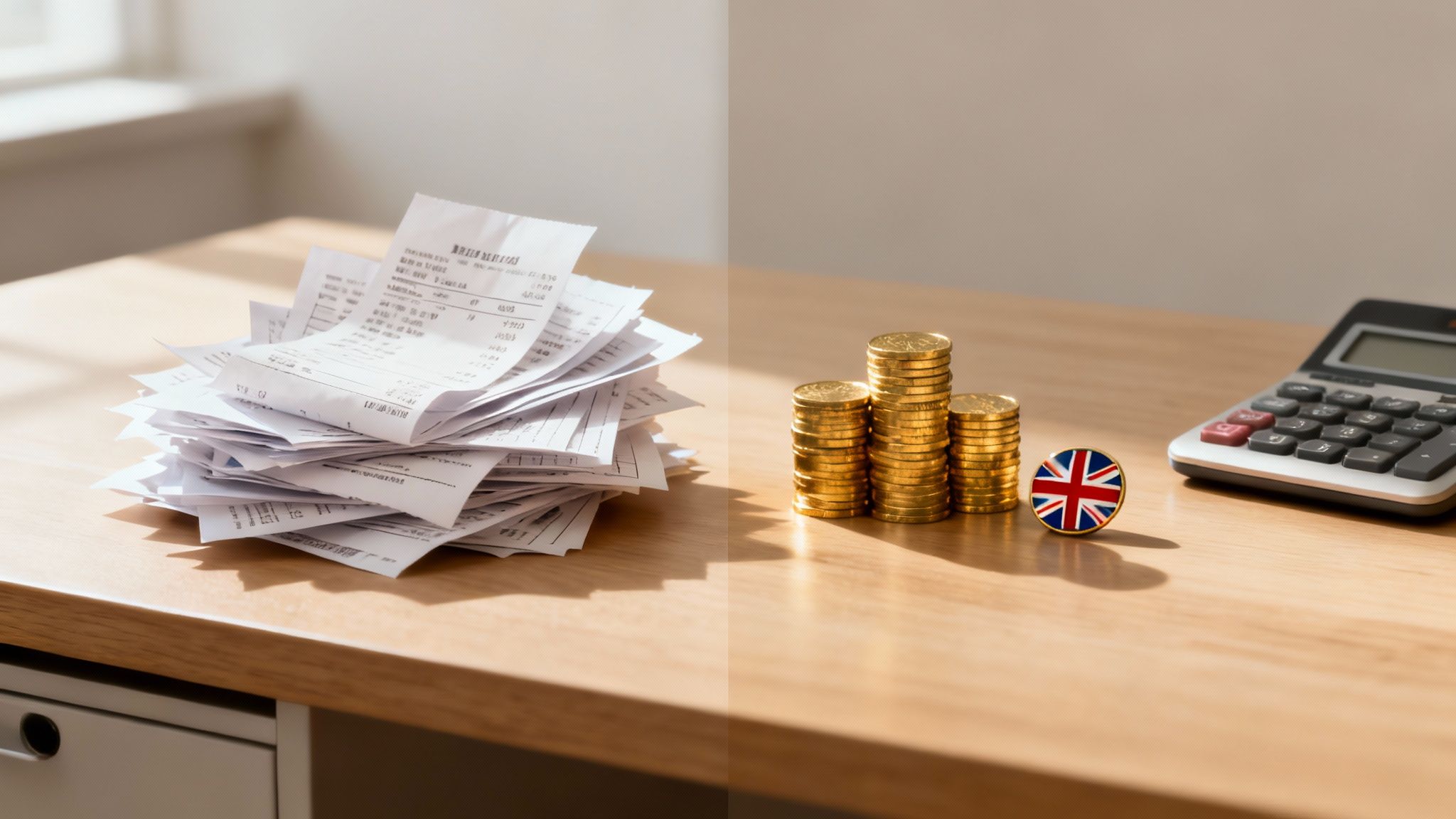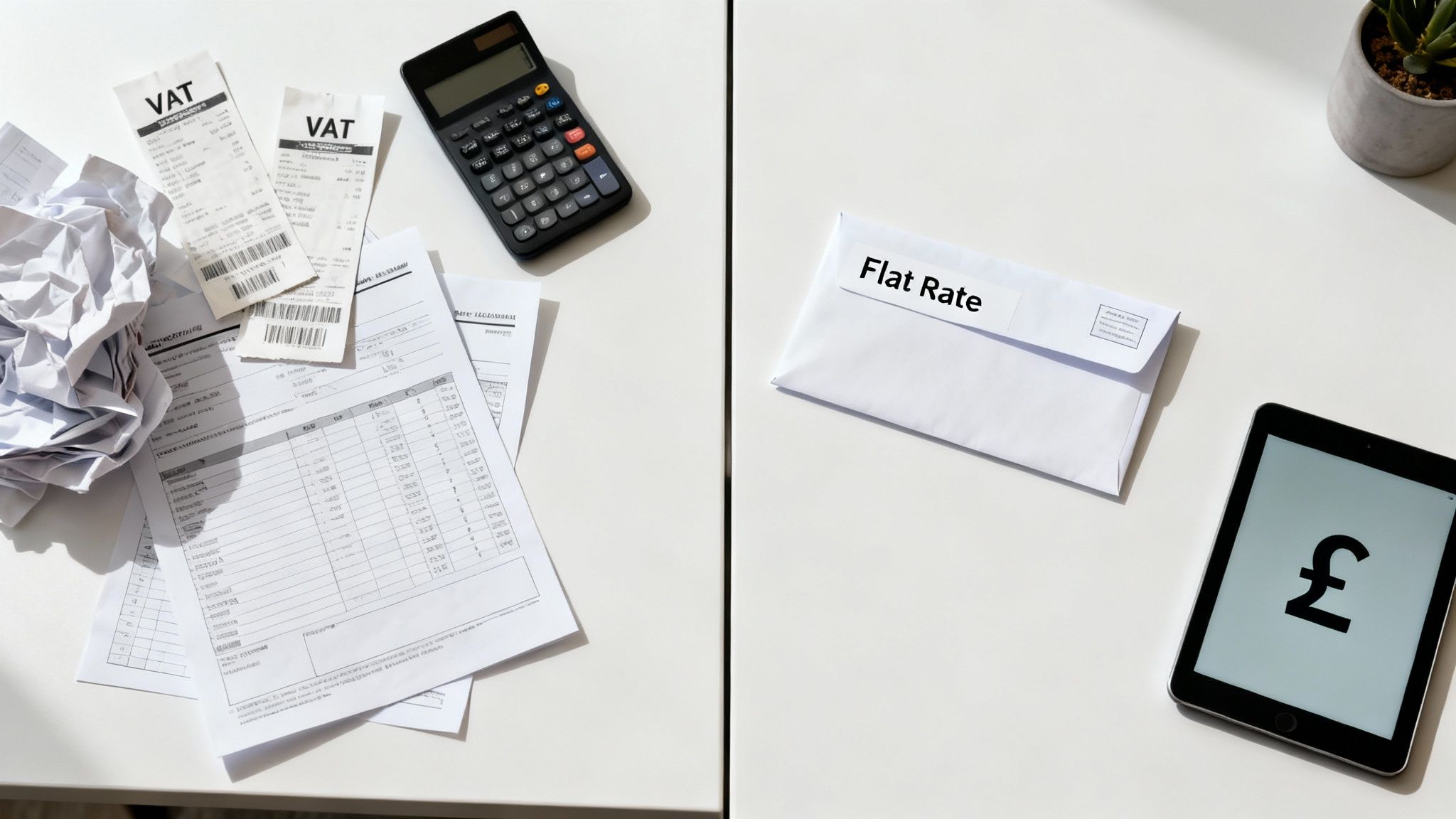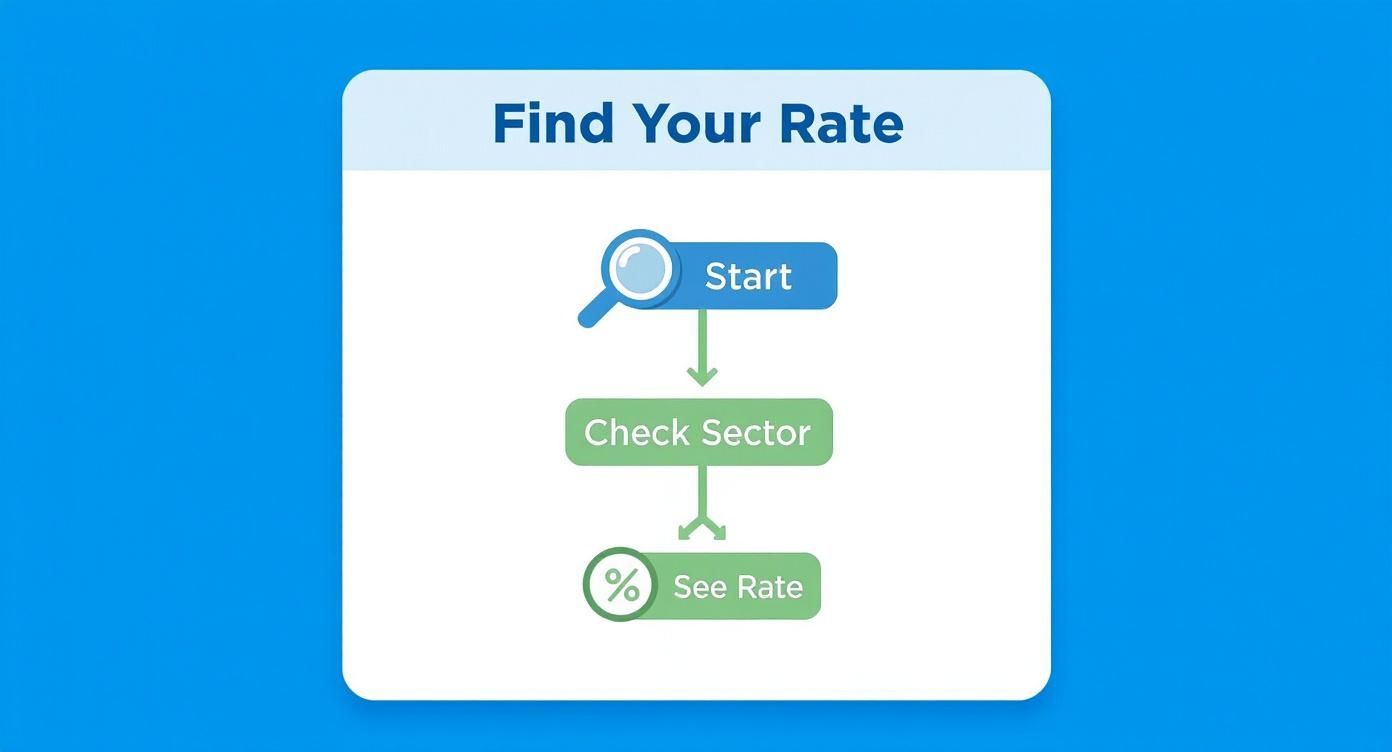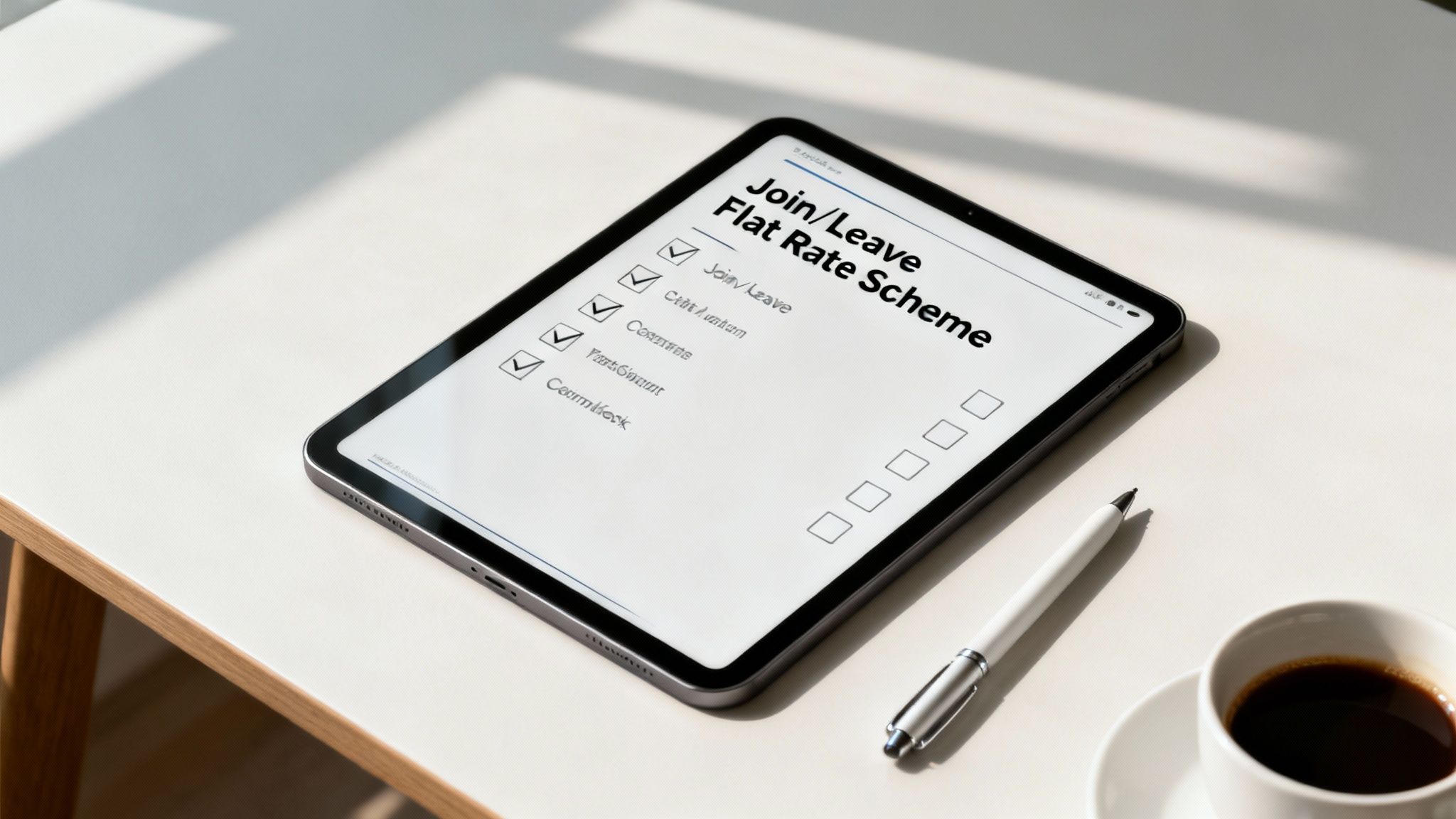
If you're running a small business, the words "VAT return" can be enough to send a shiver down your spine. Juggling input tax, output tax, and endless receipts is a headache most of us could do without. That's where HMRC's Flat Rate VAT Scheme comes in – it’s designed to slash the admin and make life simpler.
Essentially, it allows you to pay a fixed percentage of your turnover to HMRC, instead of getting bogged down in the nitty-gritty of every single transaction. For many small businesses, this is a game-changer.

Let's cut through the jargon. With standard VAT, you have to keep a running tally of two things: the VAT you charge your customers (your output tax) and the VAT you pay on your business purchases (your input tax). At the end of the quarter, you pay HMRC the difference.
The Flat Rate Scheme rips up that rulebook. You simply apply a single, fixed percentage to your total VAT-inclusive turnover. The percentage you use depends on your industry, not your individual sales or purchases.
Imagine you're managing travel expenses for work.
This radical simplification is the main draw. You still charge your customers the standard rate of VAT (usually 20%), but the calculation for what you owe HMRC is completely different.
The scheme is specifically for businesses with a VAT-taxable turnover of £150,000 or less, offering a much-needed break from complex bookkeeping.
Of course, there’s a trade-off. A big one. When you're on the Flat Rate Scheme, you generally can't reclaim the VAT you spend on business purchases and expenses. The lower flat rate percentage is designed to compensate for this.
Because you're calculating your payment based on your total VAT-inclusive turnover, getting that figure right is essential. It helps to have a clear picture of how this works, so it's worth understanding the difference between inclusive and exclusive tax. When it comes to filing, getting professional support for your VAT returns can ensure everything is spot-on and give you complete peace of mind.
Right, so you've heard about the Flat Rate VAT Scheme and you're wondering if it could simplify your life and maybe even save you a bit of cash. Before we get into the nitty-gritty of how it works, there’s a big question we need to answer first: can your business actually join?
HMRC has some pretty clear rules here. The scheme was built for smaller businesses, and they’ve put guardrails in place to make sure it stays that way. Getting this right from the start is non-negotiable.
The main gatekeeper is your VAT taxable turnover. This is just the total value of everything you sell that isn’t exempt from VAT. To get your foot in the door, your estimated VAT taxable turnover for the next 12 months needs to be £150,000 or less (before VAT is added).
It’s crucial to understand this isn't about your profit or your total sales, but specifically the turnover that VAT applies to. If you’re a brand-new business, you’ll need to make a sensible, honest forecast. For a deeper dive into how turnover works in the world of VAT, our guide on the standard VAT registration threshold is a great place to start.
To make things simple, here’s a quick checklist from HMRC. You’re good to go if:
It's also worth knowing the exit rules from day one. You must leave the Flat Rate Scheme if your annual turnover hits £230,000 (including VAT). That's not a choice; it’s a hard stop that sends you back to standard VAT accounting.
Some businesses are blocked from using the scheme entirely, no matter how low their turnover is. This is to stop it from being misused and to avoid clashes with other complex VAT rules.
HMRC won't let you join the Flat Rate Scheme if you've been on it and left within the last 12 months. The same goes if you've committed a VAT offence, like evasion.
There are also a few business structures and accounting methods that will rule you out automatically. You can't join if your business:
Checking these details before you apply will save you a world of headaches and potential trouble with HMRC down the line. If you've ticked all the right boxes, then you can start getting into the really interesting stuff – how the scheme could work for you.
So, you've checked the eligibility criteria and you're pretty sure the Flat Rate Scheme is for you. Great. The next piece of the puzzle is figuring out your specific flat rate percentage. This isn't a one-size-fits-all deal; HMRC has a list that matches different percentages to different business types.
Think of it like this: a pub owner will have a much lower flat rate than an IT consultant. Why? Because the pub is expected to buy a lot of stock (beer, food, etc.) where they'd normally reclaim VAT, whereas the consultant's expenses are typically much lower. The different rates are HMRC's way of levelling the playing field.
Finding your category on HMRC’s official list is usually straightforward. But if your business does a bit of everything, the rule of thumb is to pick the sector that makes up the biggest chunk of your turnover. Getting this right from the start is absolutely key to keeping your VAT affairs in order.
The rates can vary quite a bit, so it's worth taking a moment to see where you might fit in. The standard VAT rate is 20%, but as you'll see, these flat rates are significantly lower. That’s because the scheme is built on the idea that you’re giving up your right to reclaim VAT on most of your purchases.
Here's a quick look at some of the assigned percentages to give you a feel for how it works.
As you can see, the rates are tailored to the typical expense profile of each industry. For an online retail business, for example, you'd need to pinpoint whether you fall into a general retail category or something more specific, depending on what you sell.
Just when you think it couldn't get any simpler, HMRC throws in a pretty decent welcome bonus.
For your first year of being VAT registered (not just your first year on the scheme), you get a 1% discount on whatever your flat rate percentage is.
It’s an automatic little perk designed to ease you into the world of VAT. So, if your business sector has a rate of 11%, you’ll only pay 10% for those first 12 months. It might not sound like a huge amount, but every little helps, especially when you're starting out.
To really get to grips with these calculations, a solid grasp of understanding the concept of percentages is a massive help. Taking the time to pick the right percentage from the get-go means you’ll be filing accurate returns, staying on the right side of HMRC, and avoiding any nasty surprises down the line.
Just when you think you’ve got the Flat Rate Scheme figured out, there’s a crucial twist you absolutely need to be aware of. It’s called the limited cost trader rule, and falling into this category can completely change the numbers, often wiping out any potential savings you were hoping for.
At its heart, this rule is HMRC’s way of stopping service-based businesses—those with very few physical expenses—from getting an unfair advantage. Think of it as a safety net to ensure the scheme is used as intended.
This little infographic is a handy tool to help you find your correct rate at a glance.

As you can see, checking your business sector is only the first step. You must also figure out if you're a limited cost trader before you can lock in your final rate.
HMRC will classify you as a limited cost trader if your spending on goods (not services) is either:
You have to perform this check every single time you prepare a VAT return. If you meet the criteria, you’re forced to use a much higher flat rate of 16.5%. This is a massive jump from the typical sector rates and can completely erase the scheme's financial benefits.
The Pitfall: At 16.5%, the rate is uncomfortably close to the standard 20% VAT rate once applied to your gross turnover. This means you end up paying almost all the VAT you collect back to HMRC, but you still can't reclaim VAT on your expenses. It's often the worst of both worlds.
To bring this to life, let’s look at two very different businesses.
First up, a freelance writer. Their main costs are things like software subscriptions, web hosting, and professional insurance—all services. They might only spend £300 a year on actual goods like stationery or printer ink. Because that’s well under the £1,000 threshold, they'd be classed as a limited cost trader and stuck with the 16.5% rate.
Now, consider an online craft shop. This business is constantly buying raw materials like fabric, beads, and packaging. Their spending on goods would run into thousands of pounds a year, easily clearing both the 2% and £1,000 tests. This allows them to use their much lower, sector-specific flat rate, making the scheme worthwhile.
It really drives home how vital detailed records are for proving your spending on goods. If you need a hand keeping your expenses in order and making sure you're applying the right VAT rules, our expert bookkeeping services can provide the clarity and confidence you need.
So, is the Flat Rate VAT Scheme the right move for your business? Before jumping in, it’s worth taking a clear-eyed look at both sides of the coin.
This isn’t a one-size-fits-all solution. What works brilliantly for a consultant or freelancer might be a costly mistake for a retailer. The key is to weigh the trade-offs based on your specific business model, how much you spend on supplies, and frankly, how much you dislike doing paperwork.
For many small businesses, the biggest draw is the sheer simplicity. You can wave goodbye to the tedious job of tracking and calculating VAT on every single purchase. This predictability is a huge win for managing your cash flow, as you know exactly what percentage of your income is heading to HMRC each quarter. Less time wrestling with spreadsheets means more time for what really matters—growing your business.
But that simplicity comes at a price. The most significant drawback is that you give up the right to reclaim VAT on most of your purchases and expenses. If your business regularly buys a lot of stock, materials, or other VAT-rated goods, you could be leaving a serious amount of money on the table that you'd get back under the standard scheme.
The appeal of the scheme often boils down to these major benefits:
Now for the other side of the story. It's crucial to be aware of the potential negatives before you commit:
To help you see it all at a glance, we've put together a simple table comparing the main pros and cons.
Ultimately, making the right choice comes down to running the numbers for your own business. It’s all about figuring out whether the time you save on admin is worth more than the VAT you could be reclaiming.
Mapping out your financial situation is a core part of any successful strategy. For more on this, you can find extra guidance in our article offering tax advice for small businesses. By understanding both sides of the argument, you can make an informed choice that truly benefits your bottom line.

So, you've weighed up the pros and cons and decided the Flat Rate Scheme looks like a good move for your business. Great! The next step is applying, and thankfully, HMRC has made the process pretty straightforward.
If you're just starting out and registering for VAT for the first time, you can join the scheme as part of your online application through the Government Gateway. Already VAT registered? No problem. You can apply by sending an email or posting the form VAT600FRS. This is the key document where you’ll tell HMRC about your business and, crucially, which sector you operate in.
Don’t just skim over the business sector part. Your choice here directly determines your flat rate percentage, so it's absolutely vital to get it right. Once HMRC gives you the green light, they’ll confirm your start date, and you’ll be good to go.
Whether you're brand new or have been trading for years, the path to joining the scheme follows a few clear steps:
Of course, things change. Your business might outgrow the scheme, or you might simply decide it’s no longer the best fit.
Leaving becomes mandatory if your business grows beyond a certain point. You must leave the scheme if your total turnover in the last 12 months topped £230,000 (including VAT). The same goes if you expect your turnover to exceed that amount in the next 30 days alone.
You can also choose to leave voluntarily whenever you like. All you need to do is write to HMRC, letting them know you want to leave and the date you’d like to switch back to standard VAT accounting.
Even when you’ve got the basics down, a few common questions always seem to pop up when businesses start looking seriously at the Flat Rate Scheme. Getting the details right is key to staying on the right side of HMRC and making sure the scheme actually saves you time and money.
Let's clear up some of the most frequent queries.
This is a big one, and thankfully, the answer is yes. While you can't normally reclaim VAT on your day-to-day purchases, HMRC makes a sensible exception for significant investments in your business.
You can still reclaim the VAT on a single purchase of capital assets, as long as the VAT-inclusive cost is £2,000 or more.
Think of it this way: the scheme is designed to simplify your everyday bookkeeping for things like stationery and fuel. But HMRC knows that buying a new delivery van or a suite of high-spec computers is a totally different kettle of fish. This rule ensures you aren’t penalised for making those essential, big-ticket purchases that help your business grow.
This is a critical detail that often trips people up. Your flat rate percentage is applied to your VAT-inclusive turnover. It’s not your net sales figure; it’s the total amount of cash you actually receive from your customers, including the 20% VAT you charged them.
For example, if you send an invoice for £1,000 + £200 VAT, your VAT-inclusive turnover for that job is £1,200. You then apply your flat rate percentage to that full £1,200 to figure out what you owe HMRC.
Always, always base your calculation on the gross amount. Using your net sales figure is a common slip-up that will lead to underpaying HMRC and could land you in hot water later on.
Picking the right business sector is vital because it determines your flat rate percentage. If you suddenly realise you’ve picked the wrong one, you need to sort it out sharpish.
Get in touch with HMRC as soon as you spot the mistake. They’ll tell you what steps to take to amend any previous VAT returns and make sure you’re using the correct rate from now on. When it comes to tax, being proactive is always the best policy.
Trying to get your head around the nuances of VAT can feel like a full-time job. But you don't have to tackle it alone. GenTax Accountants offers expert, practical guidance to keep your business compliant and financially sound. Get in touch with our team today for a chat.